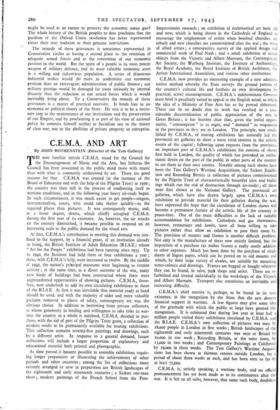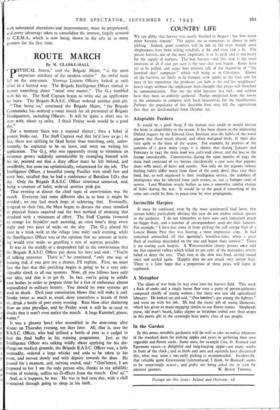C.E.M.A. AND ART
By JOHN ROTHENSTEIN (Director of the Tate Gallery) At first, C.E.M.A.'s contribution to meeting this demand was con- fined to the support, by a financial grant, of an institution already in being, the British Institute of Adult Education (B.I.A.E.) whose " Art for the People " exhibitions had been running since 1935. Up to 1940, the Institute had held three or four exhibitions a year ; these, with C.E.M.A.'s help, were increased to twelve. By the middle of 1942, the nation's principal museums were beginning to resume activity ; at the same time, as a direct outcome of the war, many new kinds of buildings had been constructed where there were unprecedented opportunities of showing pictures. C.E.M.A., there- fore, now undertook to add its own circulating exhibitions to those of the B.I.A.E. At first it was inevitable that material ready at hand should be used, and with the majority of older and more valuable pictures removed to places of safety, contemporary art was the obvious choice. In addition to borrowing from private collectors, to whose generosity in lending and willingness to take risks in war- time the country as a whole is indebted, C.E.M.A. decided to pur- chase, with the aid of part of the Pilgrim Trust grant, a collection of modern works to be permanently available for touring exhibitions. This collection contains seventy-five paintings and drawings, each by a different artist. In response to a general demand, future collections will include a larger proportion of explanatory and educational material both printed and photographic.
As time passed it became possible to assemble exhibitions requir- ing longer preparation or illustrating the achievements of other periods and other countries ; among the list of collections more recently arranged or now in preparation are British landscapes of the eighteenth and early nineteenth centuries ; a Sicken one-man show ; modem paintings of the French School from the Post-
Impressionist onwards ; an exhibition of ecclesiastical art both old and new, which is being shown in the Cathedrals of England to encourage the employment of artists when bombed churches are rebuilt and new churches are commissioned after the war ; the work of allied artists ; a retrospective survey of the applied design and commercial work of Paul Nash ; and a small exhibition of actual objects from the Victoria and Albert Museum, the Contemporary Art Society, the Warburg Institute, the Institute of Archaeology, the Royal Academy, the Royal Institute of British Architects, the Artists- International Association, and various other institutions.
C.E.M.A. now provides an interesting example of a new adminis- trative method whereby the State surveys the ground pattern of the country's cultural life and furthers its own development by practical, active encouragement. C.E.M.A.'s indeterminate .Govern- ment brief is peculiarly suited to appeal to the English mind, to which the idea of a Ministry of Fine Arts has so far proved abhorrent. There can be no doubt that its work has resulted in a con- siderable decentralisation of public appreciation of the arts in Great Britain ; it has become clear that, given the initial oppor- tunity, " consumption " is as eager, and " demand " as responsive in the provinces as they are in London. The principle, now estab- lished by C.E.M.A., of touring exhibitions has naturally lcd the provincial art galleries to show a more vivid interest in the artistic events of the capital ; following upon requests from the provinces, an important part of C.E.M.A.'s exhibitions list consists of shows first held in London, the quality of which has provoked an enthu- siastic desire on the part of the public in other parts of the country to see them in their own centres. Notable among such shows have been the Tate Gallery's Wartime Acquisitions, the Sickert Exhibi- tion and Recording Britain (a collection of pictures commissioned by the Pilgrim Trust of characteristically beautiful sites and build- ings which run the risk of destruction through air-raids) ; all these were first shown at the National Gallery. The provincial art galleries, which have also drawn largely upon C.E.M.A.'s own exhibition to provide material for their galleries during the war, have expressed the hope that the circulation of London shows will become a permanent feature of the artistic life of the country in peace-time. One of the main difficulties is the lack of suitable accommodation for exhibitions. Cathedrals and gas showrooms, however, restaurants and hotels; have all been willing to take pictures rather than allow an exhibition to pais their town by. The provision of mounts and frames is another difficult problem. Not only is the manufacture of these now strictly limited, but the imposition of a purchase tax makes frames a really costly addition to other expenses. Much has been done by the purchase of single sheets of Ingres paper, which can be pasted on to old mounts and which, by their large variety of shades, are suitable for mounting water-colours and drawings. Frames are begged or bought wherever they can be found, in sales, junk shops and attics. These are re- furbished and treated individually in the workshops of the Victoria and Albert Museum. Transport also constitutes an inevitable and increasing difficulty.
C.E.MA.'s chief success is, perhaps, to be found in its very existence, in the recognition by the State that the arts deserve financial support in wartime. A few figures may give some idea of the gratitude with which the public at large have greeted this recognition. It is estimated that during last year at least half a million people visited thirty exhibitions circulated by C.E.M.A. and the B.I.A.E. C.E.M.A.'s own collection of pictures was seen by 18,000 people in London in five weeks ; British landscapes of the eighteenth and early nineteenth centuries was seen at Bristol by to,000 in one week ; Recording Britain, at the same town, by 13,000 in two weeks ; and Contemporary Paintings at Colchester by 19,000 in three weeks. The Tate Gallery's Wartime Acquisi- tions has been shown at thirteen centres outside London, for a period of about three weeks at each, and has been seen so far by at least 75,000.
C.E.M.A. is, strictly speaking, a wartime body, and no official pronouncement has yet been made as to its continuance after the war. It is felt on all sides, however, that some such body, doubtless
with substantial alterations and improvements, must be perpetuated, and every advantage taken to consolidate the interest, largely aroused by C.E.M.A., which is now being shown in the arts in so many quarters for the first time.



























 Previous page
Previous page